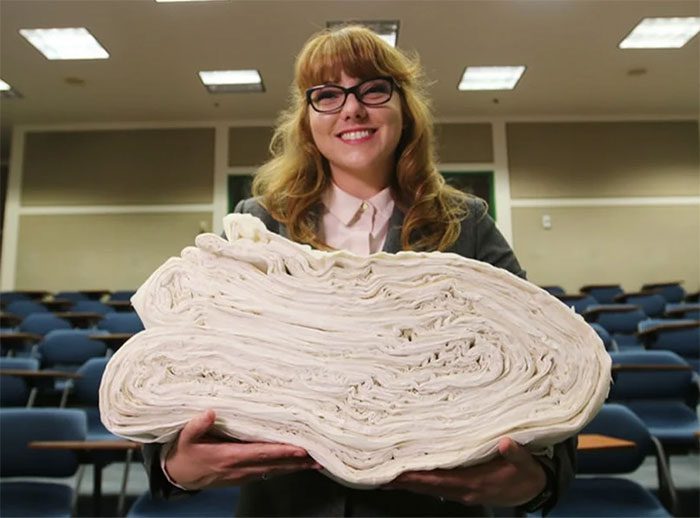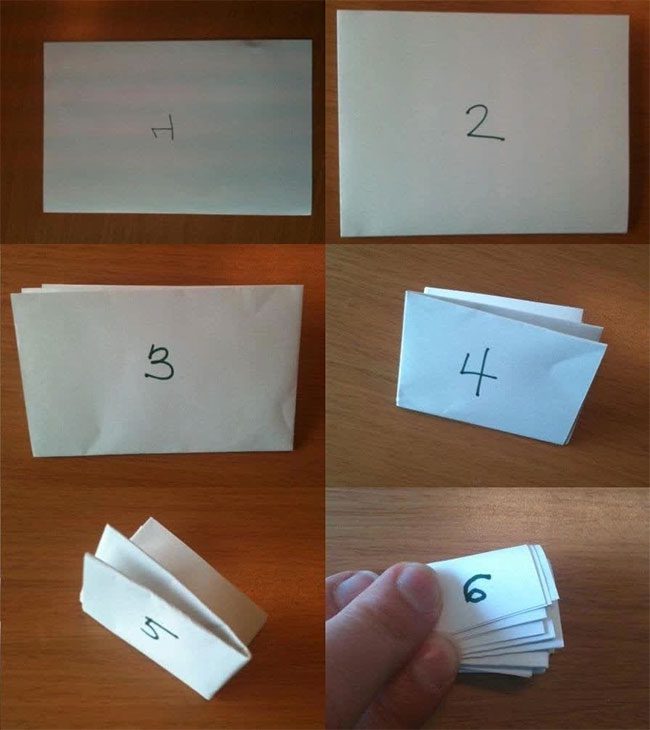Folding a piece of paper may seem easy, but in reality, it is extremely challenging, especially when we consider the power of exponentiation with the number 2.
A common assertion claims that a piece of paper cannot be folded in half more than seven times. But is this true? How many times can you fold a piece of paper?
In 2002, Britney Gallivan, then a middle school student in Pomona, California, successfully folded a piece of paper 12 times. She currently holds the Guinness World Record for the most times a piece of paper has been folded in half.
“Before my attempt, people believed that folding a piece of paper in half more than eight times was impossible, and seven times was the commonly accepted limit. I was the first to fold paper in half 9, 10, 11, and 12 times,” Gallivan told Live Science.
Interestingly, Gallivan’s motivation to achieve this feat came from an incident in her math class. Her math teacher issued a challenge to fold anything in half as many times as possible. In her first attempt, Gallivan managed to fold a thin piece of gold foil about 12 times. Later, the teacher changed the challenge to folding something thicker: a piece of paper.
Not only did Gallivan set a world record, but she also devised equations to calculate how many times any piece of paper could be folded in one direction or multiple directions. Specifically, the equations she developed calculated the number of times a piece of paper could be folded. She discovered that to fold a piece of paper multiple times, the paper itself must be both thin and long. The more it is folded, the thicker it becomes. When the thickness exceeds the length, there is nothing left to fold. This led Gallivan to search for a type of paper with suitable material.
“I began spending hours folding sheets of paper, newspapers, and any other flat materials I could find,” Gallivan said.

Britney Gallivan currently holds the Guinness World Record for folding a piece of paper – 12 times. No one has broken this record to date. Photo: Internet
Ultimately, Gallivan set her record with a silk paper she found online, which was 1,219 meters long, to be recognized in the Guinness World Records. To achieve this, Gallivan spent about 8 hours crawling down a long corridor in a shopping center in California to fold the paper.
Since Gallivan set her record, others have claimed to fold a piece of paper more than 12 times. In fact, anyone attempting to break Gallivan’s record must deal with an unexpectedly thick stack of paper. This is entirely logical mathematically.
Folding paper is not easy, mathematically speaking
For example, an average piece of paper has a thickness of about 0.1 mm. With each fold, the total thickness of the paper you hold doubles. After the first fold, the thickness is 0.2 mm; after the second fold, it’s 0.4 mm – and this still seems manageable. By the eighth fold, the thickness will be 0.1 x 2^8 = 25.6 mm, which is about the thickness of a 250-page book. By the twelfth fold, it reaches the height of a chair. By the seventeenth fold, the thickness equals that of a two-story building. Try continuing the calculations, and we will see the power of exponentiation – specifically, the powers of 2.

In the first 6 folds, this can be achieved easily. However, try continuing the calculations, and we will see the power of exponentiation – specifically, the powers of 2. (Photo: Internet)
For instance, after 42 folds, the paper will be 439,800 km thick – which exceeds the average distance between the Earth and the Moon. After 51 folds, your paper will surpass the Sun with a thickness of about 200 million km. Finally, with 103 folds, your paper will be thicker than 100 billion light-years, exceeding the diameter of the observable universe (~93 billion light-years).
Another issue to consider is the difficulty of folding paper. The thicker the paper, the more pressure you need to apply in order to fold it in half. When you attempt to fold it, the inner layers of the crease get compressed, while the outer layers need to be stretched more due to the larger angle of the crease there. This causes uneven tension in the paper. It will resist your folding attempt, making it much harder to fold a paper that has been folded 8 times compared to folding a 250-page book.
While the strength of a human hand struggles to fold a piece of paper many times, even specialized equipment like hydraulic presses also ‘give up’ on folding paper. In a video on the Hydraulic Press Channel on YouTube, an A3 sheet of paper was continuously folded 6 times before needing to use a hydraulic press. At the seventh fold, the paper exploded and turned into a piece resembling hard plastic. By the eighth fold, the applied pressure was sufficient to break the crease, collapsing like you would snap a piece of plastic and creating a loud noise.
Thus, folding paper may seem easy, but in reality, it is incredibly challenging!


















































